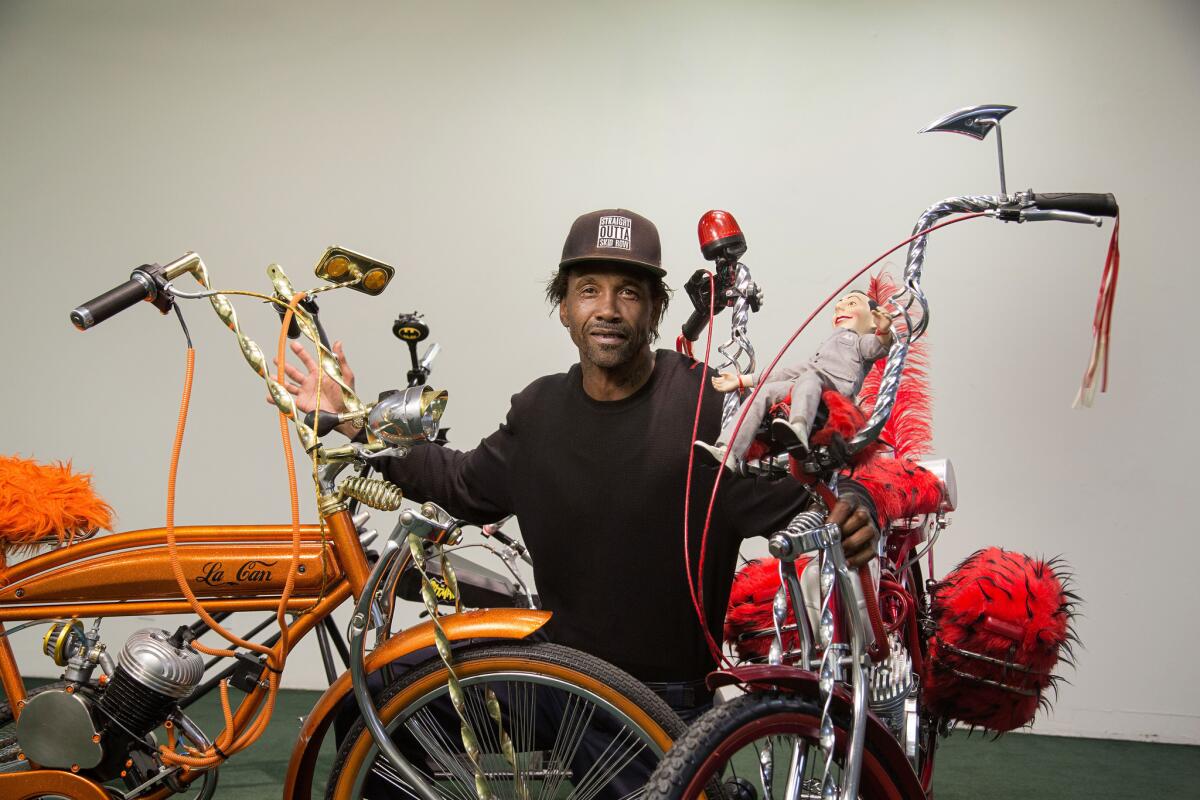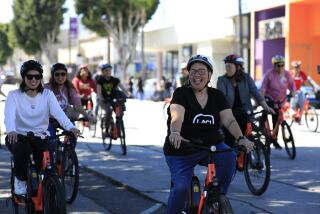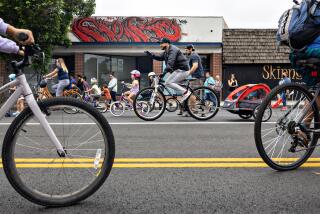Column: Lowrider bikes as activist tools: General Dogon’s rolling art works are part of Skid Row history

The activist known as General Dogon poses with his custom bikes at the Skid Row History Museum and Archive in downtown Los Angeles. The bikes are on display as part of a series of exhibitions that will chronicle the history of Skid Row.
General Dogon’s practice of creating custom bikes as art pieces began with a shopping cart.
It was sometime in the vicinity of 2012 and the activist artist, an organizer for the Los Angeles Community Action Network (LA CAN), was trying to come up with a way to get attention as he canvassed the streets of downtown L.A. advocating for services on behalf of Skid Row residents and leading awareness campaigns about their legal rights.
General Dogon, whose given name is Steve Richardson, always had a profound interest in lowrider cars. In the 1980s, he’d been a proud owner of a ’62 Chevrolet that he upgraded with shining Cragar rims, a new grill, hydraulics and “a bomb sound system.” Back in his younger days, he found that the cars were an effective way of impressing girls. He wondered: Could he achieve a similar effect on the streets of Skid Row if he transformed a grocery cart into a lowrider?
He acquired a cart and painted it orange and black. He added custom rear-view mirrors. At one point, he even explored the idea of installing hydraulics.
“It’d be able to move up and down and off to one side,” he says, mimicking the rocking motion of a car customized with hydraulic pumps.
Unfortunately, these were well beyond his budget. “One guy told me $10,000,” he says. So he settled on tricking out his ride with a DJ sound system operated by car battery.
The lowrider cart served its purpose as an art work and activism tool. In fact, it was so successful as a beacon, he used it to lead a 300-person protest against LAPD seizures of carts belonging to the homeless.
“I’m playing my music and people are coming out of their tents,” he recalls. “And then we went and did donuts around the police station.”
Soon Dogon started looking for other ways to engage Skid Row residents. It wasn’t long before he began customizing bicycles as activist tools.
He transformed a rusty 1954 Western Flyer frame into a bright orange custom ride with a fur seat and two-stroke bicycle engine. An old Dunlop was remade with shimmering, candy-colored metal flake paint and twisted chrome handlebars. He even picked up an old chopped-up motorcyle, which he redid with a Batman motif.
“I’m always thinking,” he says, “how can I bring people to the table?”
The bikes — with their wild colors and shining chrome — got General Dogon the attention he wanted. “People notice them,” he says. “I’ll pass out my flyers, use the PA system to tell people about their rights and then ride off to the next block.”
Three of Dogon’s custom bikes are now on view at the Skid Row History Museum and Archive in downtown Los Angeles, along with various video installations of the artist talking about his life and work. (Sadly, the shopping cart was not installed, since it was disassembled several years ago.)
The seven-month-old Skid Row History Museum and Archive is a storefront exhibition space operated by the cultural organization Los Angeles Poverty Department. Located in the second story of a moribund arcade mall on Broadway — above a call center and a barber shop offering haircuts for $7.50 and up — the museum is committed to telling the story of Skid Row.
“We want to make it clear that there is a longstanding community living on Skid Row,” says Los Angeles Poverty Department founder John Malpede of the project. “The area is often portrayed as a transient one. But there are many people who have lived there for a long time, on the street and in housing off the street.”
Certainly, few people personify the story of downtown Los Angeles quite like Dogon. Tall and slim, with a muscular rocker’s build, the artist, 54, is the kind of guy who knows how to tell a good story. He is also quite literally a product of downtown.
His parents met at the old Bullock’s Department Store on Broadway and 7th Street and had their first date at Clifton’s Cafeteria. “Nine months later, I was born,” Dogon with a grin.
As a youth, he lived with his mother in South Los Angeles (his parents split early on), but since her job as a housekeeper in the San Fernando Valley kept her away for long hours, Dogon would spend time with his father, who lived in downtown.
“I’d go to the movies,” he recalls. “I’d be with my father and his buddies.”
By his own account, Dogon was a bad kid. “I just kept getting into trouble,” he says. He stole. He got into fights. He began running with neighborhood gangs. After high school, he had every intention of studying business, but a growing drug habit landed him on the streets of Skid Row instead. For a time, he was homeless. And his petty crime mushroomed into regular armed robbery.
Dogon would hit the streets of the San Fernando Valley, where he would rob banks and jewelry stores and people on the street. “I never hurt anyone,” he says. “I asked people to give me their money and if they gave it to me, they gave it to me.” One local newspaper, he says rather proudly, referred to him as a “gentleman robber.”
“Once I went to rob a lady and I pointed a gun at her and told her to give me her money and she punched me in the nose!” he recalls with bellowing laughter. “I was like, ‘Damn, lady! You crazy!’”
Despite the good manners, it wasn’t long before law enforcement caught up with him. And in the early 1990s, he found himself before a judge facing several dozen counts of armed robbery. He took a plea deal for eight of them and was sentenced to 18 years in state prison. He got out in late 2003, after serving 11 years.
Prison, he says, finally straightened him out — specifically, a lengthy stay in solitary confinement after “giving it to the guards.” “That’s where I had my Malcolm X moment,” Dogon says. “I started educating myself. I started improving myself.”
At that point, he became interested in issues of black power (Dogon has the phrase tattooed on his neck) and worked with new prisoners on education. In fact, it was while in prison that he received his nickname, since, like a general, he knows how to rally the troops and get things done. (He now uses the nickname exclusively.)
It was also in prison that he discovered his activist impulses: He lobbied the prison for athletic equipment and activities such as football — and succeeded. Though not everything worked out quite like he had imagined. “I lost my two front teeth playing football in the prison yard,” he says with a wry smile. To this day, Dogon retains that football-induced gap.
After he was released, he found himself back on Skid Row, living in a hotel near the intersection of Main and Fifth Streets. It was a chance encounter there that drew him full-time into the life of an activist.
“I was smoking, standing in front of the place where I live, and a private security guard comes up to me and says, ‘Can’t you smoke while moving?’” he recalls. “I said, ‘No! I live here.’”
The guard, he says, told him that he was loitering. Dogon explained that he was not. “I explained the law to him,” he says. “I know what the law is. I’d written [legal] complaints for people in prison.”
Upon hearing the story, a neighbor suggested that Dogon become involved with LA CAN, a not-for-profit organization that helps make Skid Row area residents aware of their rights. In November 2005, he helped launch that organization’s Community Watch team, which keeps tabs on abuses by the police and private security guards, and helps defend area residents (homeless and not) against unwarranted ticketing. He has been there ever since.
The exhibition of Dogon’s work is the second show for the Skid Row museum, which last did a multimedia installation about a pair of 1970s downtown development plans — one of which would have completely wiped out the hotels and apartment buildings of Skid Row.
Through the museum’s modest exhibitions, Malpede is determined to keep stories like Dogon’s and so many other Skid Row residents alive. Throughout the years, the Los Angeles Poverty Department has gathered objects, art and oral histories by countless Skid Row residents. In the coming months, the museum intends to put these on view.
“Bazillions of dollars could be made if the residents of Skid Row could be displaced,” says Malpede, of downtown’s ongoing gentrification. “But we’re here to show that there’s a community here — and that there are people who are trying to make it better.”
“General Dogon: Screaming Two Wheelers,” is view at the Skid Row History Museum and Archive through Dec. 18. 440 S. Broadway, downtown Los Angeles, lapovertydept.org.
Find me on Twitter @cmonstah.
More to Read
The biggest entertainment stories
Get our big stories about Hollywood, film, television, music, arts, culture and more right in your inbox as soon as they publish.
You may occasionally receive promotional content from the Los Angeles Times.







